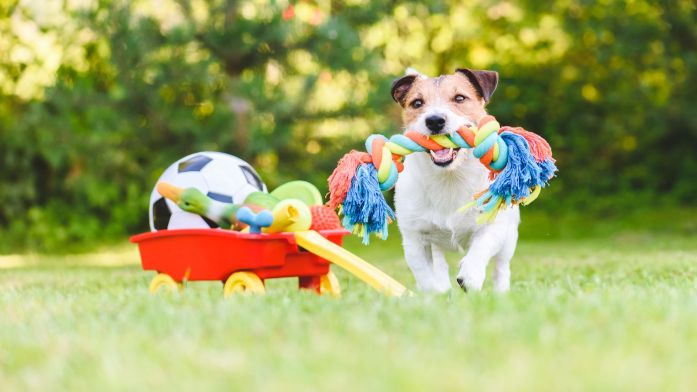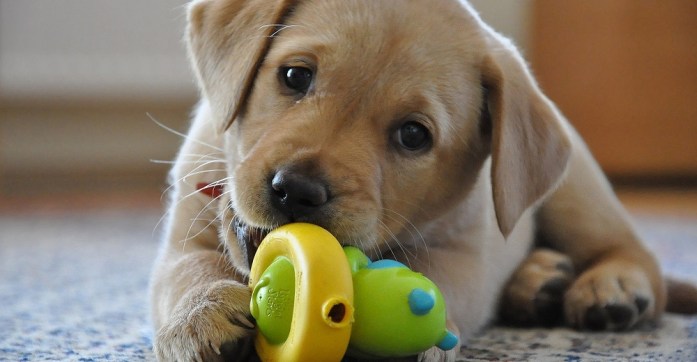In order to keep our pets entertained, we as pet owners often want our pets to have an abundance of toys. These can include anything from plush toys, squeaky balls, chew toys, interactive toys and more! However, with more play, it means the need for regular cleaning of your pet’s toys to stay sanitised!
Do you recall your pets chewing and slobbering on their toys? If so, it is important that you wash your pet’s toy regularly. Similar to kid’s toys, pet’s toy get dirty quickly too! Hence, it is vital that you wash their toys regularly to sanitise them.
Simply throwing your pet’s toys into the washing machine will not solve the problem! This is because different toys may require different forms of cleaning. Moreover, not all toys are safe for washing in the washing machine. Therefore, this article will provide you with a brief guide on how you can properly wash, clean and sanitise your pet’s toys.
Why Is Cleaning Pet’s Toys Important?

It is important to wash your pet’s toys regularly even if they do not appear to be dirty. Their toys can carry multiple different types of bacterias such as yeast, mould and staph bacteria. According to National Sanitation Foundation (NSF), one of the germiest household items include pet toys! Hence, it is vital that we wash our pet’s toys regularly.
In addition, our pets use their mouths to chew and play with their toys. They could possibly ingest any of the bacteria or dirt present on the surface of the toys. On top of that, cats groom themselves by licking their furs and paws; the germs ingested from licking the surfaces might result in poor health. The germs could also spread to humans when your pets lick you and this could result in a cycle of public health concern (disease or illness). Hence, cleaning your pet’s toys would greatly benefit the health of your pet’s, family and yourself!
Is It Time To Throw Away My Pet’s Toy?

Should I throw or wash my pet’s toy? When is it time to throw this you away? These are questions pet owners often ponder upon in their mind. In order to decide, pet owners should always take the time and effort to regularly inspect their pet’s toys.
In the case if you notice any signs of damage to the toy, the best solution is to throw it away. Any signs of damage could include loose strings, feathers, stuffings, openings, sharp edges or any other issues that are dangerous to your pets. Any observed damaged or loose threads on a toy should still be throw away and you should find a replacement toy. This is because damaged toys when swallowed could pose a choking hazard and result in blockage in both the digestive and respiratory tract.
How Should I Store My Pet’s Toy?
Outdoors, wet and humid environments are non-favourable for storing your pet’s toys. Wet and humid environments will expose the toys to mould, mildew and other germs and/or bacteria. Store the toys in a clean and dry place when your pet is not playing with them.
Guide To Cleaning Pet’s Toys
Rope Toys

Rope toys are especially challenging to wash; they are not as easy to clean as rubber or plastic toys. In addition, they are especially prone to germs, mould and bacteria as the curvature and corners trap drool and moisture easily.
Hence, in order to sterilise your dog’s rope toy, you should place the toy in the microwave for a minute under high heat after soaking it in clean water. However, drying using the microwave should not be an option if your pet’s toy contain rings, metals or non-suitable washer-safe materials and/or parts. Instead, follow the product care instructions stated on the specified product page.
An alternative to properly clean and disinfect a rope toy would be running it in the washer on a hot cycle with no detergent or pet-safe detergent and dry with a dryer.
Plush Toys

Similar to rope toys, plush toys are another popular breeding ground for germs. Therefore, washing and sanitising your pet’s plush toy often is necessary. Washing and drying using the washing machine and dryer is suitable for most plush toys, unless stated otherwise.
The same cycle used to wash sturdier plush toys cannot be used to wash soft plush toys. This is because, softer materials were used and using the same cycle could damage the plush toy. If there are no specified instructions, it is your judgement call to use the appropriate cycle to launder your pet’s plush toy.
In order to wash soft plush toys, put them on washing on gentle cycle and in warm water. On the other hand, a regular cycle and hot water is suitable for washing sturdier plush toys. However, if you are unsure and still in doubt, you can always play it safe by putting the plush toy into a laundry mesh bag and washing it on a gentle cycle.
Most, if not all plush toys is suitable for drying using a dryer. Despite that, if your pet’s plush toy contain crinkle fillings or squeakers, air-drying them would be the best.
Catnip Toys

Catnip toys drive your cats crazy and excited. It is expected that your cats will drool and chew on their favourite catnip toy. However, cleaning them with soap, detergent and fabric softener will contaminate the catnip in the catnip toy. Hence, you should simply rinse your cat’s catnip toy with warm water, wring them out and allow them to air dry. You should not wash the catnip toys using a washer or dry them with a dryer.
Some catnip toys are designed specifically to allow for refills; these are toys that are easiest to clean! Simply wash the catnip toy and dry after removing the old catnip stuffings and replace with fresh new ones.
Nylon, Rubber And Plastic Toys

Many would categorise washing toys made of plastic, nylon and rubber using a dishwasher. However, some toys may not be dishwasher safe. It is therefore important that you check the specific product care instructions before proceeding to wash your pet’s toy. Some toys may become structurally damaged which may result in leakage of dangerous chemicals.
Plastic is fragile and can lose its shape when exposed to heat. Most, if not all interactive puzzle toys are made from plastics, this means that they are not suitable for washing using the dishwasher. Plastic toys are also not suitable for washing in the dishwasher as they could become damaged during the process of washing.
Hand washing is another great way to wash your toys. Use antibacterial soap or a pet-safe detergent and a scrub brush to clean off any dirt, grime and germs that may be trapped in crevices.
For particularly dirty toys, you can soak them in a tub of vinegar water at a ratio of two parts of water to one part of vinegar solution. Soak the toys for a duration of about 15 minutes before washing them. Ensure that the toys are rinsed and dried thoroughly before returning them to your pet.
If you are thinking of gifting your cats or dogs some new toys in the new year. Click on the links to find out more!



